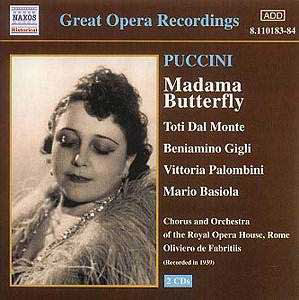The fourth complete Butterfly was the last pre-war
recording of the opera. It dated from July 1939 and is still one of
the most convincing. Unlike its predecessors this recording strives
for a complex dramatic narration of Cio-Cio-San’s tragedy. Toti Dal
Monte‘s portrait of the fifteen year old Japanese girl who marries the
American Lieutenant B. F. Pinkerton and her naive belief in his love
which will finally bring her to suicide, has electrified generations
of opera lovers down the decades. This is a legendary recording, which
has set standards not only in vocal quality, but also in interpretation.
Astonishingly this is the only recording of Beniamino
Gigli singing the music of Butterfly. Unlike most of his other
operatic roles, from which he recorded at least the main arias in extra
sessions, his Pinkerton has only been preserved through the recording
sessions of July 1939. He starts with youthful naturalness and brilliance
("Amore o grillo") in the opening scene and with a charming
honey-sweet timbre, coloured with the flame of youth and the lyricism
of poesy in the great Act One duet with Dal Monte. His "Addio,
fiorito asil" is a wonderful example of forceful phrasing and organic
legato singing. It arises out of the melody. Gigli, being almost fifty
years old, when this recording was made, was still in splendid shape,
able to draw a character only with slight variations in the timbre of
his voice, from the shades of his mezza voce in Act One to the
dynamic outbursts of his gorgeous secure intonation in the last act.
Toti Dal Monte’s Butterfly has become famous for her
girlish characterisation. Consequently she uses her voice to bring out
the naive and innocent side of Cio-Cio-San. Though this is not free
of artificial moments, her voice control is nothing less than brilliant.
And the stressing of a naturalistic interpretation of Butterfly as a
young girl is never at the cost of the beauty of her voice. Butterfly
has been, together with Mimi in Puccini‘s La Bohème, a
milestone in Dal Monte’s career, who had started as a coloratura soprano.
From today’s point of view - with experience of the great 20th-century
Butterflys like Callas, Tebaldi, Oliviero or Freni - her lyric timbre
may seem a bit too light, and her voice is not as profound in the suicide
scene as the pathos of the music requires. Her conception of the character
comes from another tradition - a turn-of-the-19th-century
tradition where the boundary between the ‘lyric Fach’ and the ‘dramatic
Fach’ had not yet developed. Accordingly she follows and counteracts
the harmonic, timbral and rhythmic elements in the orchestration with
the magnificent floating simplicity of her splendid soprano. Interaction
instead of dramatic self-representation makes this portrait moving and
convincing.
Oliviero de Fabritiis and the forces of the Rome Opera
House join her in that concept. The orchestra always has equal rights
to comment on the love and the tragedy. There is none of the highlighting
of drama and passion we are used to from Karajan or Sinopoli. De Fabritiis
avoids the pathos wherever possible and emphasises the naturalism of
the story. The range from almost impressionistic colours (humming chorus
and act two interlude) to harsh dramatic emotions (final scene) is full
of surprises.
It is to the credit of Ward Marston, one of the most
celebrated producers and engineers of historic recordings, that this
Naxos set has such a transparent and warm sound. Notably the source
for this edition was an RCA Victor shellac pressing, and not the usual
HMV counterpart. The outcome is brilliant. This recording has not been
over processed, like so many other re-issues today, but has retained
its wonderful strong and deep sonic clarity. A slight trace of hiss
remains, but does not disturb the joy of hearing this centenary recording.
The 2CD set is filled out with eight solo recordings
of Toti dal Monte. These date from 1928 to 1941. Considering her popularity
she made relatively few recordings, only some 50 all in all. While the
three opening arias (from Donizetti and Bellini) present her as the
world-famed lyric coloratura soprano from the 1920s and early 1930s,
the following two pieces (by Verdi and Mascagni) show her long, lovely,
legato lines and her sensitive phrasing. The last three selections (songs
by Bianchini and Sadero) illustrate her instinctive musicality and feeling
for intimate interpretations.
With Toti Del Monte’s art of singing we have documents
of the first – unconscious - attempts at a new way of interpretations,
away from the art-pour-art bel canto of the 19th century;
her Butterfly might be the first recording in this sense.
Uwe Schneider


![]() See
what else is on offer
See
what else is on offer 